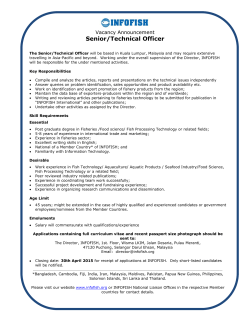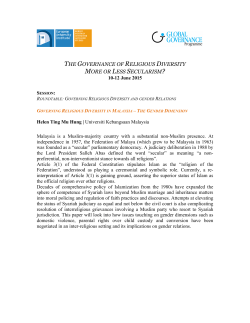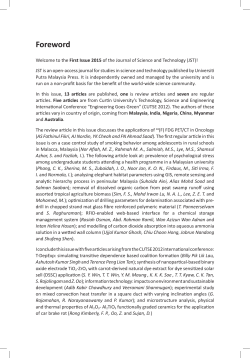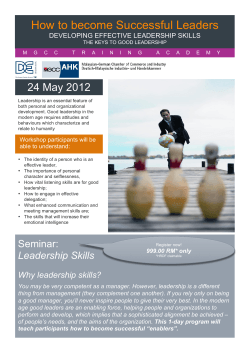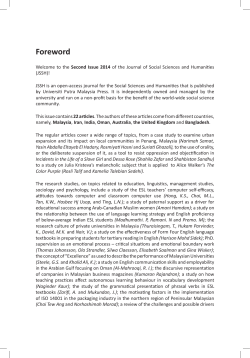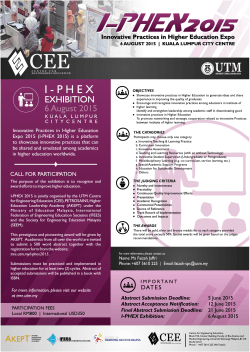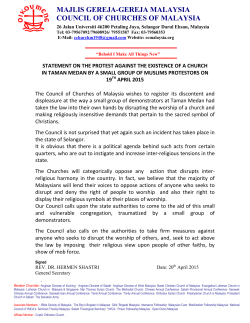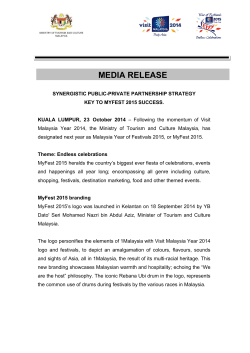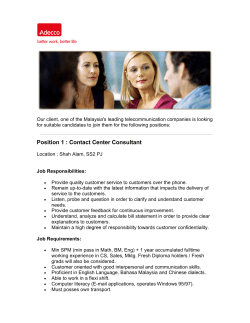
Eleventh Malaysia Plan: Anchoring growth on people
Eleventh Malaysia Plan: Anchoring growth on people Anchoring growth on people In retrospect The next five years Challenges and opportunities Macroeconomic outlook Six strategic thrusts and six game changers Transforming public service for productivity Malaysia beyond 2020 Conclusion 1-1 Anchoring growth on people The Eleventh Malaysia Plan, 2016-2020, is the final leg in the journey towards realising Vision 2020. Launched in 1991, Vision 2020 envisions Malaysia as a fully developed country along all dimensions - economically, politically, socially, spiritually, psychologically, and culturally - by the year 2020. Emboldened by the great strides made in the last half decade, the Eleventh Plan reaffirms the Government’s commitment to a vision of growth that is anchored on the prosperity and wellbeing of its rakyat. The Eleventh Plan is premised on a progressive and united Bangsa Malaysia that shares a common commitment towards building a better Malaysia for all Malaysians. The development of the Eleventh Plan was guided by the Malaysian National Development Strategy (MyNDS), which focuses on rapidly delivering high impact on both the capital and people economies at low cost to the government. The capital economy is about Gross Domestic Product (GDP) growth, big businesses, large investment projects, and financial markets, while the people economy is concerned with what matters most to the people, which includes jobs, small businesses, the cost of living, family wellbeing, and social inclusion. Accordingly, the Eleventh Plan is a strategic plan that paves the way for Malaysia to deliver the future that the rakyat desires and deserves. It represents the Government’s commitment to fulfilling the aspirations of the people. The Eleventh Plan is based on the theme “anchoring growth on people” and has six strategic thrusts and six game changers that will transform ideas into reality, and address in concert the goals set out in Vision 2020 so as to catapult Malaysia towards the end state of being an advanced economy and inclusive nation. Eleventh Malaysia Plan Chapter 1: Anchoring growth on people This word cloud captures important concepts and themes, and terms commonly used in the Eleventh Malaysia Plan 1-2 1-3 In retrospect ONE OF THE BEST Real GDP 6.2 % per annum Malaysia has enjoyed one of the best economic growth records in Asia over the last five decades despite a multitude of challenges and economic shocks. The economy achieved a stable real GDP growth of 6.2% per annum since 1970, successfully transforming from a predominantly agriculture-based economy in the 1970s, to manufacturing in the mid-1980s, and to modern services in the 1990s. 25X increase in per capita income RM Malaysia rose from the ranks of a lowincome economy in the 1970s to a high middle-income economy in 1992 and remains so today. Malaysia’s national per capita income expanded more than 25-fold from US$402 (1970) to US$10,796 (2014) and is well on track to surpass the US$15,000 threshold of a high-income economy by 2020. MALAYSIA Eleventh Malaysia Plan Chapter 1: Anchoring growth on people 0.6 % Between 1970 and 2014, the incidence of poverty in general was reduced from 49.3% to 0.6% while hardcore poverty has been eradicated. incidence of poverty Household monthly income 1970 RM264 2014 RM6,141 The mean household monthly income increased more than 20-fold from RM264 in 1970 to RM6,141 in 2014. Similarly, median income increased from RM166 to RM4,585 over the same period. Income inequality has also narrowed, as reflected by the Gini coefficient, from 0.513 in 1970 to 0.401 in 2014. 76.1% Home Ownership Today, Malaysians from all walks of life, irrespective of ethnicity, socio-economic background, and geographic location, enjoy a better quality of life. Approximately 76.1% of households are homeowners, with 75.3% of poor households owning homes as well. 95.1 % 97.6% of the population have access to potable water have access to electricity 1-4 Malaysians today live longer, with life expectancy increasing by more than 10 years to 75 years. They are also better educated with 27% of the labour force having a tertiary level qualification, a fourfold increase from 1980. Mobility has improved tremendously with better connectivity provided by extensive road, rail, and air networks. 12 th 20 th TOP 20 In 2014, Malaysia was rated the 12th most competitive country among 60 countries in the World Competitiveness Yearbook by the International Institute for Management Development. 20th out of 144 countries in the Global Competitiveness Index (GCI) 2014-2015 by the World Economic Forum; and 18th among 189 economies in the Doing Business Report 2015 by the World Bank. Malaysia also scores highly as a top 20 investor-friendly destination for the period between 2014 and 2018, in the Economist Intelligence Unit’s 2014 Business Environment Rankings. 1-5 All these gains were made possible by Malaysia’s development philosophy, which places the prosperity and wellbeing of the rakyat at the heart of economic growth. This commitment can be seen in each successive development policy: New Economic Policy National Development Policy National Vision Policy National Transformation Policy 1971-1990 1991-2000 2001-2010 2011-2020 The New Economic Policy, 19711990, focused on poverty eradication irrespective of ethnicity and eliminating identification of ethnicity by economic function. The National Development Policy, 1991-2000, focused on ensuring the balanced development of major sectors of the economy and regions, as well as reducing socio-economic inequalities across communities. The National Vision Policy, 2001-2010, focused on building a resilient and competitive nation. The National Transformation Policy, 2011-2020, maintains the people-centric focus through the New Economic Model, which sets the goal of becoming a high-income economy that is both inclusive and sustainable. This transformation agenda is supported by the Economic Transformation Programme, which focuses on the 12 economic areas that are most critical to the nation’s continued growth, and the Government Transformation Programme, which focuses on transforming areas of public service that are of greatest concern to the rakyat. The Government has also introduced MyNDS to strengthen implementation approach. Eleventh Malaysia Plan Chapter 1: Anchoring growth on people 1-6 The next five years The Eleventh Plan is formulated with the rakyat as the centrepiece of all development efforts. The people economy will be given priority, reinforcing the Government’s commitment to bring further development to the people by enriching their lives, providing people dignity, and uplifting their potential to partake in the prosperity that is generated. All segments of society must benefit from the country’s economic prosperity in order to create an advanced economy and inclusive nation by 2020. In line with this, for the first time in Malaysia’s history, national growth targets will include not only GDP growth and per capita income, but also household income and the Malaysian Wellbeing Index to assess the impact of economic growth on people’s wellbeing. Average national income The Government aspires for Malaysia to achieve an advanced economy status by 2020, with a national per capita income of MORE THAN US$15,000 While there will still be people who earn less than this threshold, all segments of society, irrespective of geography, ethnicity, or income level, are expected to experience an increase in their income and wellbeing. Every household will have access to efficient infrastructure and public amenities, quality healthcare and education, quality and affordable housing, and comprehensive support services. The goal is nothing less than a better quality of life for all Malaysians. 1-7 Challenges and opportunities The next five years are expected to be challenging with continued uncertainties in the global economy, particularly given the prospect of low prices for crude oil and other major commodities, and the risk of a slowdown in the economies of major trading partners. On the domestic front, there needs to be greater resolve to boost productivity to drive economic growth; strengthen the fiscal position while ensuring adequate public funding to support continued economic expansion; and raise the average income and share of total income of the bottom 40% household income group (B40 households) to become truly inclusive. The Eleventh Plan also opens up new opportunities, particularly with the establishment of the ASEAN Economic Community (AEC) of more than 600 million people in a single market, which will be a boost to trade and investment. Domestically, Malaysia will exploit its demographic dividend of a young and growing population with a median age of around 30 and a working age population of close to 70% to accelerate growth. Malaysia’s multi-racial and multicultural society is another unique asset, which has yet to be exploited to its fullest in terms of its natural affiliation with Islamic nations, the People’s Republic of China, India, and as a rich tourist attraction. Macroeconomic outlook During the Eleventh Plan, real GDP is targeted to expand between 5%-6% per annum. The Gross National Income (GNI) per capita is expected to reach US$15,690 (RM54,100) and therefore exceed the US$15,000 minimum threshold of a high-income economy. The Plan is expected to create 1.5 million jobs by 2020, with targeted improvements in labour productivity through the continuous shift from labour-intensive to knowledge- and innovation-based economic activities. Growth will be driven by the private sector with private investment expanding at 9.4% per annum. All economic sectors will witness strong growth with the manufacturing and services sectors contributing more than 75% of GDP. The external sector is also expected to contribute positively with recovery in exports and the current account of the balance of payments is projected to remain in surplus at 2.6% of GNI. The Federal Government fiscal position is expected to consolidate further and achieve a balanced budget by 2020. Inflation is expected to remain benign, below 3%, and the economy is anticipated to maintain full employment. Malaysia’s economic fundamentals will be strengthened to achieve sustainable growth by ensuring stable prices and exchange rates, and an adequate level of savings as a source of investible resources. The Government will also promote private consumption, as well as private investment in agriculture, manufacturing, and services to spearhead economic growth, and increase exports by improving product competitiveness, promoting services exports, and diversifying markets. More prudent fiscal management will be introduced to enhance fiscal flexibility, and measures will be undertaken to unlock the potential of productivity to ensure sustainable and inclusive growth. The Eleventh Malaysia Plan used Blue Ocean Strategy (BOS) tools and frameworks, as part of the National Blue Ocean Strategy (NBOS), to formulate national strategies that are high impact, low cost and able to be rapidly implemented. BOS is about creating uncontested market space by simultaneously pursuing differentiation and low cost. For businesses, this means delivering high value to customers while lowering costs to the business. For governments this means rapidly delivering high value to the people at low cost to the government. One key BOS tool used in the formulation of the Eleventh Plan was the strategy canvas – a diagnostic and action framework for visualising strategies. The canvas depicts the current situation and compares it to the new strategic direction the Government will take in the Eleventh Plan. Eleventh Malaysia Plan Chapter 1: Anchoring growth on people Six strategic thrusts and six game changers Moving forward, the Eleventh Plan provides a critical platform for the country to make vital policy shifts and invent new approaches to address new and existing challenges. It cannot be business as usual if Malaysia is to make the transition to an advanced economy and inclusive nation in the space of the next five years. Strategic thrusts The Government has defined six strategic thrusts to help Malaysia stay ahead of the challenges and opportunities of the fast-changing global and political landscape. These thrusts aim to comprehensively address the end-to-end needs of the rakyat and the nation. Game changers The Government has also identified six game changers, which are innovative approaches to accelerate Malaysia’s development, that once successfully applied, will fundamentally change the trajectory of the country’s growth. Four of these game changers are critical to the development of an advanced economy – they aim to unlock productivity for accelerated sectoral growth; unleash innovation to generate new sources of revenue; harness TVET for the transition to a higher-skilled workforce; and develop cities as a source of competitiveness. To ensure that all Malaysians are able to participate in and benefit from this growth, the Government will raise the income and wellbeing of the B40 households. Finally, the Government will embark on green growth to shift the paradigm of sustainability from a narrow focus on natural assets, to include consumption and production processes in all sectors and households. 1-8 1-9 Six strategic thrusts Enhancing inclusiveness towards an equitable society Improving wellbeing for all Accelerating human capital development for an advanced nation Inclusivity has always been a key principle in Malaysia’s national socioeconomic development agenda, and a fundamental goal of the New Economic Model. This commitment to enable all citizens – regardless of gender, ethnicity, socio-economic level, and geographic location – to participate in and benefit from the country’s prosperity, is anchored on a belief that inclusive growth is not only key to individual and societal wellbeing, but also critical for sustaining longer periods of solid economic growth. The Government has always adopted a balanced development approach that gives equal emphasis to both economic growth and the wellbeing of the rakyat. Wellbeing refers to a standard of living and quality of life that addresses an individual’s socio-economic, physical, and psychological needs. Wellbeing is essential to enhancing productivity and mobility, while simultaneously strengthening social cohesion and national unity. Human capital development is a critical enabler for driving and sustaining Malaysia’s economic growth and supporting the transition of all economic sectors towards knowledge-intensive activities. An efficient and effective labour market is also necessary to attract investments into Malaysia and enable everyone to participate in and enjoy the benefits of economic growth. Towards this end, the Government is committed to ensuring equitable opportunities for all segments of society, in particular the B40 households. All Malaysians, and in particular vulnerable groups will benefit from better access to quality education and training, efficient infrastructure and social amenities, better employment and entrepreneurial opportunities, as well as wealth ownership. Rural areas will be transformed with improved connectivity, mobility, and a conducive business environment. All households will witness an increase in income, and the B40 households will be elevated towards a middle-class society. The status of the Bumiputera economic community will be further enhanced. The Government will improve the wellbeing of all Malaysians – regardless of socioeconomic background or geographic location. Every Malaysian will have equal access to quality healthcare and affordable housing. Neighbourhoods and public spaces will be safer, allowing the rakyat to have peace of mind and for communities to thrive. Sports and physical activity will become an integral part of life, with most, if not all Malaysians embracing a healthy lifestyle. Most importantly, there will be greater social integration leading to a more united and cohesive Malaysian community. The Government will improve labour productivity and create more job opportunities that require highly-skilled workers. Technical and Vocational Education and Training (TVET) will shift towards industry-led programmes to produce the skilled talent to meet industry needs. The existing workforce will have many opportunities to continuously enrich and develop themselves, so as to stay relevant in the changing economy. Above all, the quality of education will be raised to develop talent with both the knowledge and skills, and ethics and morality, to thrive in a globally competitive and dynamic environment. Eleventh Malaysia Plan Chapter 1: Anchoring growth on people Pursuing green growth for sustainability and resilience Strengthening infrastructure to support economic expansion 1-10 Re-engineering economic growth for greater prosperity Green growth refers to growth that is resource-efficient, clean, and resilient. It is a commitment to pursue development in a more sustainable manner from the start, rather than a more conventional and costly model of ‘grow first, clean up later’. A reinforced commitment to green growth will ensure that Malaysia’s precious environment and natural endowment are conserved and protected for present and future generations. Infrastructure development ensures that the rakyat have access to essential amenities and services such as transport, communications, electricity and clean water. Better integration of different transport modes will create seamless movement for people and goods. Moreover, an efficient infrastructure lowers the cost of doing business, which in turn improves national competitiveness and productivity. Good infrastructure is therefore the foundation of social inclusion, economic expansion, and growth. Robust economic growth is crucial to ensure that the aspiration of becoming an advanced economy is attained. A strong and broad-based economy, producing high-value goods and services, will generate the high-paying jobs associated with an advanced nation. The economy must be placed on a solid foundation to withstand external shocks and generate undisrupted prosperity for the people. Malaysia’s green growth strategy will lead to better quality of growth, strengthened food, water and energy security, lower environmental risks and ecological scarcities, and ultimately better wellbeing and quality of life. It will mean significant reduction in greenhouse gas emissions and improved conservation of terrestrial and inland water, as well as coastal and marine areas including its ecosystems. Sustainable consumption and production practices will increase the adoption of energy-efficient and low carbon buildings, transport, products, and services. Climate change adaptation measures and disaster risk management, as well as the protection and conservation of natural resources, including biodiversity, will be intensified to protect the nation and its development gains. New investments in road, rail, and air services will be balanced with efforts to improve the productivity, efficiency, and service levels of such infrastructure. Digital access will be increased through both broadband infrastructure expansion and initiatives to ensure their affordability. Efficiency of the logistics sector and trade facilitation will be enhanced, making Malaysia the preferred logistics gateway to Asia. Expansion and investment in new water and sewerage networks and treatment capacity will continue. Emphasis will also be placed on improving the security and reliability of the energy sector by addressing both supply-side and demand-side measures. All economic sectors will migrate into more knowledge-intensive and high value-added activities. In the services sector, there will be a shift towards modern services, which include Islamic finance, ecotourism, ICT, the creative industry, the halal industry, and oil and gas. The manufacturing sector will shift towards more diverse and complex products in three catalytic subsectors, namely chemicals, electrical and electronics, and machinery and equipment. Agriculture will be modernised by promoting sustainable practices and adopting modern farming technology to generate high-income. Growth across all economic sectors will be supported by productivity improvements, innovation, better talent, and greater internationalisation. 1-11 Game Changer Unlocking the potential of productivity Why is productivity important for Malaysia? How will this be achieved? In the past, Malaysia’s economic growth has been predominantly input-driven, supported by private investments in industry and public investments in infrastructure, utilities, as well as in schools and hospitals. Despite efforts to improve productivity, Malaysia continues to lag behind many high-income economies. For example, Malaysia’s labour productivity level was 32% that of the United States’ and 56% that of South Korea’s in 2013. While Malaysia will continue to boost private investment and undertake public investment during the Eleventh Plan, it will place greater emphasis on increasing productivity to achieve a more sustainable, inclusive, and high rate of economic growth. Malaysia’s approach to productivity will shift, from primarily Government-driven initiatives at the national level to targeted actions across the public sector, industry players, and individual enterprises, with champions identified to role model change and ensure buyin across stakeholders. Broad-based initiatives will be developed and tailored for each sector with targets set and monitored. At the national level, productivity-linked incentives will be introduced and regulatory reforms will be accelerated. At the industry level, industry champions will spearhead industry-specific productivity initiatives, while at the enterprise level, incentives and upskilling programmes will be provided. Collectively, these strategies will produce a set of major shifts as laid out below. What will success look like? During the Eleventh Plan, labour productivity will reach RM92,300 in 2020 from RM77,100 in 2015. In addition, sectoral growth will accelerate due to improvements in productivity. Approach From To Fragmented productivity initiatives, typically at national level Focused and comprehensive strategies at all levels – national, industry, and enterprise Led by Government Spearheaded by industry champions and industry associations, and supported by Government via the National Productivity Council Focused on manufacturing sector and selected services subsectors Covers all sectors, including agriculture, construction and the public sectors Generic programmes without clear targets Programmes closely aligned with industry needs as per relevant industry master plan Champion Industry focus Program design Regulation revamp Oversight Incentives not linked to performance Programme incentives linked to outcomes Little to no linkages between regulations or policies with productivity Linkages established between government regulations or policies with productivity Oversight only at the national level Increased oversight across enterprise, industry, and national level Eleventh Malaysia Plan Chapter 1: Anchoring growth on people Game Changer Uplifting B40 households towards a middle-class society Why is uplifting the B40 households important for Malaysia? Today, there are 2.7 million B40 households with a mean monthly household income of RM2,537. As Malaysia continues to grow, the B40 households should not miss out on the opportunities that come with national prosperity. Allowing the B40 households to remain in their current socio-economic status will create social costs for all Malaysians, as it reduces the number of skilled workers needed to grow national output, perpetuates urban inequality, and limits the growth potential of rural and suburban areas. What will success look like? All B40 households regardless of ethnicity will be given greater focus, especially the urban and rural poor, low-income households, as well as the vulnerable1 and aspirational2 households. The size Approach Scope Characteristics and composition of middle-class society will grow to 45% by 2020. The mean income of the B40 households will double to RM5,270 in 2020 from RM2,537 in 2014. More B40 households will have family members with tertiary education, from 9% in 2014 to 20% in 2020. The income share of the B40 households to national household income will also increase from 16.5% in 2014 to 20% in 2020. How will this be achieved? The Government will implement strategies to raise the income and wealth ownership of the B40 households, address the increasing cost of living, and strengthen delivery mechanisms for supporting B40 households. The Government will also introduce the Multidimensional Poverty Index (MPI) to ensure that vulnerability and quality of life is measured in addition to income. The major shifts that will occur are set out below: From To Lifting B40 households above the poverty line through improved income levels and assistance with living costs Uplifting B40 households to middle-class society by further improving income levels and wealth creation, as well as increasing education and skill levels Assisting B40 households with individual micro-enterprises Fostering community and social-based enterprises in the B40 community, in addition to individual enterprises Focus on developing microentrepreneurship and economic activities in low-value, traditional industries Building capacity to participate in high-productivity, innovative, and creative economic activities B40 households have low wealth and non-financial asset ownership, and are easily affected by economic shocks B40 households are able to save and build wealth including through non-financial asset ownership, making them more resilient to economic shocks B40 households are highly reliant on government assistance B40 households are independent and rely less on government assistance programmes 1 Vulnerable households refer to households with income between Poverty Line Income (PLI) and 2.5 times PLI. 2 Aspirational households refer to households with income between 2.5 times PLI and national mean income. 1-12 1-13 Game Changer Enabling industry-led Technical and Vocational Education and Training (TVET) Why is TVET important for Malaysia? Supply matches demand, and there are robust quality control mechanisms which ensure that all public and private institutions meet quality standards; Industry and TVET providers collaborate across the entire value chain from student recruitment, through to curriculum design, delivery, and job placement; and Students are well-informed of the opportunities that TVET can offer and view TVET as an attractive pathway. Students also have access to a variety of innovative, industry-led programmes that better prepares them for the workplace. How will this be achieved? Achieving these aspirations will require harmonising and streamlining how the system currently operates to reduce fragmentation across the various public and private stakeholders. Furthermore, efforts will be made to encourage industry-led interventions and programmes as they are the stakeholders best placed to ensure that the supply of graduates meet their requirements. A summary of the major shifts that will be undertaken are set out as follows: Governance Programme delivery An effective and efficient TVET sector is one where: Capacity What will success look like? From Profile Under the Eleventh Plan, 60% of the 1.5 million jobs that will be created will require TVET-related skills. Meeting this demand will require Malaysia to increase its annual intake gradually from 164,000 in 2013 to 225,000 in 2020. Yet, the challenge is not merely about numbers. Industry feedback consistently reveals a disconnect between the knowledge, skills, and attitudes these graduates possess, and what is required in the workplace. To 2 Accreditation Agencies (MQA and DSD) with different sets of qualifications Single qualification system adopted by both MQA and DSD Different quality rating systems for public and private TVET institutions, depending on which Ministry the institution is registered with Single rating system for both public and private TVET institutions Design and delivery of curriculum led by individual TVET institutions or Government Design and delivery of curriculum led by industry, in partnership with TVET institutions and Government No specialisation among TVET institutions Institutions to specialise in and create Centres of Excellence in niche areas of expertise 164,000 intake in 2013 225,000 intake per annum in 2020, by maximising use of existing institutions Limited recognition and low premium Career of choice for students Eleventh Malaysia Plan Chapter 1: Anchoring growth on people Game Changer Embarking on green growth Why is green growth important for Malaysia? Malaysia, like many countries across the world, is grappling with the challenge of balancing a growing population and demand, with a natural environment that is increasingly under stress. In the global context of increasing intensity and frequency of extreme weather events, adopting green growth has now become an imperative for Malaysia. It represents Malaysia’s commitment to renew and, indeed, increase its commitment to the environment and long-term sustainability. What will success look like? A successful green growth trajectory will ensure: From Detrimental impact of socio-economic activity on environmental systems is reduced; Quantity of growth landfill Development gains are protected, thus ensuring wellbeing of people across generations; and Energy use is efficient and renewable energy is widely used. How will this be achieved? Achieving these aspirations requires a fundamental shift away from a ‘grow first, clean up later’ development model towards one that views resilient, low-carbon, resource-efficient, and socially inclusive development as an upfront investment that will yield future gains over multiple generations to come. This requires fundamental changes across every major dimension including how policy is determined, how institutions are regulated, how responsibilities are shared, and how people value their environment. Climate change mitigation and adaptation as a Government’s Resource and energy responsibility intensive Climate change mitigation and adaptation as an Shared responsibility Resource and energy cost Quality of growth To Waste to Natural capital, including forested areas, biodiversity, and water resources as well as its ecosystems, is valued and sustainably managed; that takes into consideration the cost to the climate, environment, and the nation’s natural resources Waste as resource that can be reused through recycling and recovery, for power generation, and other waste to wealth initiatives investment that is accounted for during the upfront planning and investment stages between the government, private sector, and individual citizens efficient in balancing both supply-side and demand-side considerations and constraints 1-14 1-15 Game Changer Translating innovation to wealth Why is innovation important for Malaysia? Innovation is a key driver for economic growth as it raises productivity through new or improved processes, technologies, and business models. In addition, innovation can create additional sources of revenue through differentiated products and services that serve unmet customer needs. As Malaysia continues to move towards a high-value, knowledge-based economy with a strong focus on the services and manufacturing sectors, innovation will be crucial to raise the overall efficiency and thus productivity of each sector. What will success look like? In the enhanced innovation ecosystem, there will be greater collaboration and integration across industry, academia, and communities. Research will be closely aligned with industry demand, and the private sector will be active partners in the research, development, commercialisation, and innovation (R&D&C&I) process by contributing funds, expertise, and other resources. Communities Enterprise innovation Social innovation will be actively engaged in addressing social issues through a wholesociety approach in the provision of social services. There will be a greater return on investment from innovation. How will this be achieved? The Eleventh Plan will focus on strengthening relational capital by improving collaboration among all stakeholders. Innovation will be targeted at both the enterprise and societal levels, instead of previous efforts which focused primarily on national-level initiatives. At the enterprise level, initiatives will enhance demanddriven research, improve collaboration between researchers and industries, and encourage private investment in R&D&C&I. At the societal level, communities will be encouraged to provide input into social service delivery mechanisms, while a social financing model will be developed to assist communities to fund new initiatives. Collectively, these strategies will produce a set of major shifts as set out in the table below: From To Collaboration between industry and research institutes is limited, resulting in R&D output that is not linked to industry demand Better partnerships between industry and researchers, with industry helping to shape research to ensure relevance to business, and contribute ideas, infrastructure, tools, and expertise Investments in R&D have low returns and do not drive competitiveness and productivity for industry Integrated R&D&C&I initiatives generate high return on investment over time and stimulate productivity growth High investments in social services but delivery is ineffective Focus on streamlining social services delivery by incorporating feedback from the community in line with the “whole-society approach” Communities remain dependent on the government Delivery supported by a Social Financing Model and outcomebased funding to provide communities with avenues to invest in innovative initiatives Eleventh Malaysia Plan Chapter 1: Anchoring growth on people Game Changer Investing in competitive cities Urban form Cities have always played an important role in a nation’s growth by providing investment and trade opportunities, as well as improving connectivity with rural and suburban areas. Today, global competition for investment and talent is increasingly between cities, making it imperative to invest in cities in order to attract and retain investment and talent. Kuala Lumpur, the largest city in the nation, is expected to contribute 14.8% of GDP in 2015. As Malaysia aims to re-engineer and spur economic growth, the development and renewal of cities will be crucial to create nodes for strong economic agglomeration. Economic density Why is investing in cities important for Malaysia? City Competitiveness Master Plans will be developed for four major cities as a start, based on key principles that increase liveability and stimulate economic growth. These include creating density to increase efficiency; expanding transit-oriented development to enhance mobility; and strengthening knowledge-based clusters to facilitate agglomeration and innovation. These master plans will take into account each city’s competitive advantages, and will be formulated by the respective local authorities in consultation with the private sector and civil society. The major shifts that this gamechanger will produce are summarised in the following chart. 3 Kuala Lumpur, Johor Baharu, Kuching, and Kota Kinabalu Housing Industry focus How will this be achieved? Role of local authorities By 2020, four major cities3 in Malaysia will have undergone a stepchange in their economic growth, importance as talent hubs, and liveability. City residents will be able to afford urban housing, have adequate public transportation systems, enjoy green and open spaces, and have access to economic opportunities that will enable them to provide their children with a better future. While these four cities – selected based on their strong fundamentals – will serve as pioneers, the transformation will be expanded to other cities over time. These cities will serve as role models for other cities in the country and region. Resource usage What will success look like? From To Economic density in cities is unplanned and organic, resulting in lower productivity Increased economic density to enhance productivity Uncontrolled and automobile-focused sprawl Transit-oriented development to increase use of public transportation and reduce reliance on personal vehicles Resource use not streamlined, leading to high usage of natural resources Efficient waste management through guidelines on resource use and effective enforcement New developments are expensive and exclusive with limited affordable options Affordable and quality housing is accessible to targeted segments of the society Current industries are predominantly labourand space-intensive industry Growth of knowledgeintensive industries with efficient use of space Local authorities focused on licensing, enforcement, and provision of basic services Local authorities as strategic drivers of local economic and social development 1-16 1-17 Transforming public service for productivity To support the delivery of the six strategic thrusts and six game changers, the Government is committed to transforming the public service by becoming more citizen-centric and enhancing the productivity, efficiency, and effectiveness of service delivery. The aspiration is to deliver public service in a less bureaucratic, hierarchical, and centralised manner; with talent that is multiskilled; and a range of service offerings that is more accessible and innovative. To achieve these outcomes, the Government has identified five focus areas: Enhancing service delivery with citizens at the centre by eliminating unnecessary bureaucratic processes, expanding the outreach of its services, and increasing accountability; Rationalising public sector institutions for greater productivity and performance by reducing overlapping roles and functions among agencies, right sizing the public service, and introducing an exit policy for underperformers; Strengthening talent management for the public service of the future by providing a more conducive working environment including flexible work arrangements, empowering ministries and agencies, and upgrading public sector training; Enhancing project management for better and faster results by improving the process of project selection and resource allocation, establishing dedicated project implementation teams, and creating a pool of professional project management personnel; and Capitalising on local government for quality services at the local level through greater engagement with local community and NGOs, expanding the outreach and quality of service, and further empowering local authorities in terms of capacity and capability. Malaysia beyond 2020 The Eleventh Plan not only marks the culmination of a 30-year journey towards Vision 2020; it also sets the stage for the next horizon of growth. Post-2020, the challenge will be to raise the bar even higher on the country’s growth prospects along three dimensions, namely economy, people, and environment. The vision is for all Malaysians to have an unshakeable national identity and clear moral compass. The country will be governed by trusted and independent executive, legislative, and judicial institutions that protect all Malaysians equally. Malaysians will have a government that delivers and is led by leaders with integrity and conviction who embrace the concept of amanah. Malaysia will punch above its weight in the international arena, both as a strong independent nation and through prominent Malaysian thought leaders in various fields. The economy will be progressive, inclusive, and adaptable for the future, with highly productive world-class cities and thriving rural areas. All Malaysians will be able to participate in and benefit from the country’s growth, and enjoy an elevated state of wellbeing. Malaysians will be passionate stewards of the environment and no longer see environmental protection as a trade-off to a strong economy, making Malaysia a truly beautiful place to live for all. The aspirations described above are neither exhaustive nor conclusive, but are intended to set in motion the prospect for further engagement and serious deliberation. Essentially, Malaysians envision a strong sovereign nation that is progressive and inclusive and for the people to treasure unity and celebrate diversity. Eleventh Malaysia Plan Chapter 1: Anchoring growth on people Conclusion The Eleventh Plan is significant as it will be the last five-year plan before Vision 2020 is achieved. It provides a crucial platform to ensure that Malaysia transitions to an advanced economy and inclusive nation. Towards this end, the Eleventh Plan has been formulated with the rakyat as the focal point of all development efforts – to enrich their lives, raise their dignity, and enable them to partake in the country’s economic prosperity. Six strategic thrusts and six game changers have been defined to break the country out of “business as usual” practices and set Malaysia on an accelerated growth trajectory. The Eleventh Plan strives for a future that is built on sound macroeconomic policy, inclusiveness so that no Malaysian is left behind, improved wellbeing for all, human capital development that is future-proof, green and sustainable growth, infrastructure that supports economic expansion, and a citizen-centric public service with high productivity. Collectively, these improvements will ensure that everyone, regardless of gender, ethnicity, socio-economic status and geographic location, can live in a truly harmonious and progressive society that bears the mark of an advanced economy and inclusive nation. 1-18
© Copyright 2025
